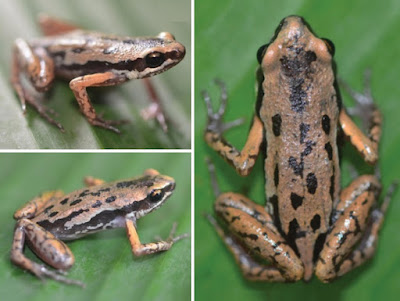 |
| Micryletta thongphaphumensis Cao, Suwannapoom, Kilunda, Wu & Che, in Cao, Suwannapoom, Kilunda, Gao, Wu, Wu et Che, 2024. |
Abstract
The genus Micryletta is widely distributed in South China and Southeast Asia. Although significant progress has been made in the diversity and taxonomy of this genus over the past few years, the distribution range and taxonomy of some species still remain controversial, especially in M. inornata sensu lato. Consequently, limitations at national borders have resulted in a lack of comparative research on species from different countries. To resolve the classification dispute, assess species diversity, and determine the distribution range of Micryletta, a series of specimens were collected from the Yunnan Province of China and Thailand during herpetological surveys from 2009 to 2020. Subsequent analyses based on morphological and molecular data revealed a distinct and previously unknown lineage from western Thailand, which we formally describe as a new species. Furthermore, our study confirms that M. ‘inornata’, previously known from Mengla, Yunnan, was actually M. menglienica, and further extends its distribution range to Thailand and Laos. In addition, our findings extend the latitudinal distribution of M. inornata and M. subaraji northward into southern Thailand. Notably, this study brings the total number of known species in the genus Micryletta from 13 to 14, with the count rising from three to six species in Thailand and from one to three in Laos. Our study further confirms that species diversity within the genus Micryletta is underestimated and emphasizes the important role that international collaborations play in taxonomy. Intensifying field surveys in other regions (e.g., Myanmar, Vietnam, and Guangxi of China) will be extremely necessary in the future to clarify any taxonomic questions and reevaluate the distribution range of these species.
Key Words: Distribution range, diversity, Micryletta, M. inornata sensu lato, new species
 |
| Adult male holotype (KIZ 024670) of Micryletta thongphaphumensis sp. nov. in life. A. Dorsal view; B. Lateral view of left side; C. Lateral view of right side. Photos by Jing Che. |
Micryletta thongphaphumensis Cao, Suwannapoom, Kilunda, Wu & Che, sp. nov.
Diagnosis: Micryletta thongphaphumensis sp. nov. is assigned to the genus Micryletta based on the following combination of morphological traits: small body size; absence of vomerine teeth; tympanum small and externally visible; subarticular tubercles on fingers and toes prominent; three well-developed metacarpal tubercles; absence of webbing between fingers and toes (Dubois 1987; Fei et al. 2009). The new species differs from its congeners by a combination of the following characters: medium-sized within the genus (SVL 21.3–25.6 mm in males, n = 5; 24.4–29.7 mm in females, n = 4; Table 3); snout truncate in dorsal view; tympanum distinct; supratympanic fold absent; a black streak extending from tip of the snout to crotch; upper lip white; tibiotarsal articulation adpressed limb reaching level of tympanum; lack of webbing between fingers and toes; relative finger lengths: I < II < IV < III; relative toe lengths: I < II < V < III < IV; outer metatarsal tubercle absent; ventral skin of body and limbs smooth; brown marbling patterns on dorsal limbs; dorsal orange-brown with black spots (Fig. 4).
...
Etymology: The specific name is a Latinized toponymic adjective in neuter gender derived from ‘‘Thong Pha Phum’’ in reference to the type locality Thong Pha Phum District in Kanchanaburi Province, Thailand.
Suggested common name: We propose “Thong Pha Phum Paddy Frog” as the common English name.
expand article infoYu-Yang Cao, Chatmongkon Suwannapoom, Felista Kasyoka Kilunda, Wei Gao, Chun-Lian Wu, Yun-He Wu and Jing Che. 2024. Taxonomic Revision of the Genus Micryletta (Amphibia, Microhylidae), with Description of A New Species from Thailand. Zoosystematics and Evolution. 100(4): 1361-1373. DOI: doi.org/10.3897/zse.100.129398